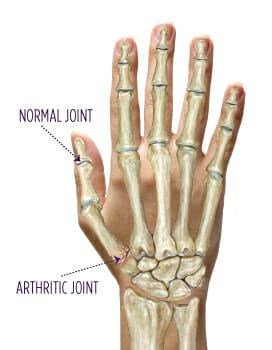
Arthritis of the hands often develops when the protective cartilage that cushions your joints wears away. Without this cushioning, the bones rub against each other, often causing pain, stiffness and swelling.
There are two main types of arthritis that affect the hands:
- Osteoarthritis (OA): OA is the most common form of arthritis. It develops slowly over time as the cartilage in your joints breaks down, and it usually affects people ages 45 and older. OA is often found in the hips, hands, knees or back. Rarely, osteoarthritis can develop many years after an injury or trauma or after infection in a joint.
- Rheumatoid arthritis (RA): RA is an autoimmune disease that develops when your immune system mistakenly attacks the lining of your joints, causing pain, swelling and damage. RA often affects the hands and wrists, but it can impact many different joints in the body. Women are two to three times more likely to have RA. It frequently develops after age 50, but it can affect younger people as well.
Summit Orthopedics’ hand and wrist specialists provide expert diagnosis and treatment for hand arthritis at locations throughout the Minneapolis/St. Paul area.
Hand Arthritis Symptoms
Symptoms of arthritis in the hands can start off mild and become worse over time. If you have arthritis of the hands, you might experience these common symptoms:
- Cracking or popping sounds in the joints: Feeling or hearing a grating sensation in your joints (called crepitus)
- Hand joint pain or stiffness
- Joint deformities, where fingers may look crooked or become misaligned
- Pain in finger joints
- Reduced range of motion/difficulty fully bending or straightening fingers
- Swollen knuckles
- Wrist pain or swelling
Hand Arthritis Causes
Several things can lead to arthritis in the hands. The most common causes and risk factors include:
- Aging: Cartilage breaks down as you age.
- Genetics: If your family members have arthritis, you may be more likely to develop it.
- Previous injuries or infections: These issues may make your hands more prone to arthritis.
- Repetitive hand use: Jobs or hobbies that require repeated hand movements, like typing or knitting, may increase your risk of hand arthritis.
- Smoking: If a family member smoked in the home when you were a child, it increases your risk of RA.
When Should I See a Doctor for Hand Arthritis?
If you have ongoing finger joint pain, swelling, stiffness, or other signs of arthritis in the hands, you should see a doctor. Early hand arthritis treatment can help prevent long-term joint damage and improve your daily life.
Arthritis in the fingers or hands can be painful and make everyday tasks difficult, but with the right treatment and lifestyle changes, you can manage your symptoms and continue to enjoy your life.
Diagnosing Hand Arthritis
If you have ongoing pain, stiffness, swelling or trouble moving your hands, it’s important to see a doctor. Early diagnosis and treatment can help you manage symptoms and keep your hands working well with fewer symptoms.
It’s especially important to diagnose rheumatoid arthritis as early as possible, because early treatment can slow disease progression and protect your arthritic joints from more damage in the future.
Your doctor will use several tests and evaluations to diagnose your arthritis:
- Medical history: Your doctor will ask questions about your symptoms. They will want to know about your symptoms, previous injuries and any family history of arthritis.
- Physical exam: Your doctor will perform a thorough evaluation of your hands and wrists for signs of arthritis.
- Blood tests (for RA): Certain antibodies and inflammation markers can show up in bloodwork if you have RA. Your doctor may choose to order lab tests that can show signs of rheumatoid arthritis.
- Imaging tests: Your doctor may order X-rays, MRI scans or ultrasound to evaluate your hands.
Treating Hand Arthritis
Although arthritis has no cure, doctors have many nonsurgical options to help manage the pain and improve your ability to use your hands.
Medications
There is no “best” pain reliever for arthritis, because medications may work differently for your specific pain. However, one or more of these options may offer relief.
- Over-the-counter pain relievers like ibuprofen or naproxen can help reduce pain and swelling.
- Topical creams with anti-inflammatory ingredients can be applied directly to the skin over the painful joints.
- Prescription medications, such as disease-modifying anti-rheumatic drugs (DMARDs), can slow the progression of rheumatoid arthritis in the hands.
- Corticosteroid injections contain strong anti-inflammatory medication that can reduce symptoms of pain and swelling.
Ice or Heat
Applying ice to the affected areas on your hands can help reduce pain and swelling, while heat may help alleviate joint stiffness, improve circulation and loosen tight muscles. Ice or heat is usually applied for a short period of time—usually about 20 minutes—several times a day.
Hand Therapy
Hand therapy can help relieve symptoms of arthritis. Hand therapists are specially trained to use several different techniques to help improve strength and motion in your hands.
Assistive Devices
Elastic bandages, splints or braces can support your hands and prevent further damage. Your hand therapist can help you find the right device or create a custom splint based on your needs.
Surgery
Doctors generally try other treatments before resorting to surgery, but surgery may help you If other treatments aren’t relieving your pain or improving function in your hands. Doctors may also recommend surgery if your hand arthritis is very severe. Surgery may help reduce symptoms of arthritis if you have not responded to other treatments.
Surgery can involve removing or replacing damaged joints or fusing the bones in the joints together. Your doctor will talk to you about the recommended surgery for your specific problem and goals.
Find your Summit Orthopedics hand expert, request an appointment or call us at (651) 968-5201 to schedule a consultation.
